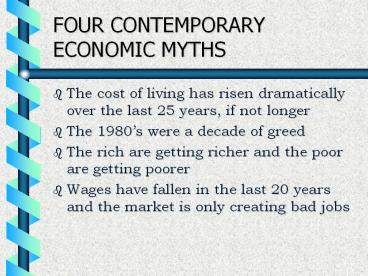FOUR CONTEMPORARY ECONOMIC MYTHS PowerPoint PPT Presentation
Title: FOUR CONTEMPORARY ECONOMIC MYTHS
1
FOUR CONTEMPORARY ECONOMIC MYTHS
- The cost of living has risen dramatically over
the last 25 years, if not longer - The 1980s were a decade of greed
- The rich are getting richer and the poor are
getting poorer - Wages have fallen in the last 20 years and the
market is only creating bad jobs
2
Myth 1 The cost of living has steadily risen
over the last few decades.
- The ultimate measure of the cost of consumption
goods is the labor time needed to purchase them - The rich pay the big up-front costs by purchasing
them when they are very expensive - The increase in variety is one of the best signs
of increasing well-being and a rising standard of
living
3
Table 1 Changes in the Labor Time Cost of
Various Consumer Goods
4
Table 1 Changes in the Labor Time Cost of
Various Consumer Goods
5
Myth 2 The 1980s were a decade of greed
- As a percentage of national income, total and
individual charitable giving reached all-time
highs in 1989 - In addition, these levels of giving were ahead
of what one would have predicted given past data.
6
Table 2 Charitable giving - 1980s and before
7
Myth 3 The rich are getting richer and the poor
are getting poorer
- Even if the relative shares of the poor declined,
this doesnt take account of the overall growth
in income. - The people who were poor in one year are not the
same people who are poor in the next year! - There are also more persons per household at the
top than the bottom (64m vs 39m). - The real policy question here is income
mobility. How easy is it for folks who start
poor to move their way up?
8
Table 3 US Income Distribution by Quintile,
1997
9
Table 4 US Income Distribution to Top and
Bottom Quintile 1975 and 1997
10
Table 5 Income Mobility 1979 to 1988 (US
Treasury Data)
11
Table 6 Income Mobility 1975 to 1991 (UM Data)
12
Table 7 Absolute Average Income Change, by
Quintile 1975-91 (1997 dollars)
13
Myth 4 Wages have fallen in the last 20 years
and the market is only creating bad jobs
- From 1953 to 1973, average hourly wages grew at
an annual rate of 2. From 1973 to 1978, they
stagnated. And then from 1978 to 1996, they fell
by an average annual rate of 0.7. - These figures include only monetary wages, they
neglect other forms of compensation, such as
health benefits, retirement benefits, and stock. - When we look at per capita income rather than
wages or total compensation, we get a
continuation of the same upward trend we saw from
1953 to the mid 1970s, albeit once again at a
slower rate.
14
Myth 4 Wages have fallen in the last 20 years
and the market is only creating bad jobs
- Economists believe that inflation is overstated
by 1.1 per year. If we correct for that, the
decline in real wages since 1978 becomes a 12
increase, and the slowdown in per capita income
growth disappears. - It's true that most of the jobs created over the
last 25 years have been in the service sector,
but thats part of a long term trend that is the
most basic sign of economic growth - In fact, the average wage in the service sector
is 11.80/hr compared to 13.20/hr in
manufacturing. Not a huge difference and one that
is rapidly shrinking. The difference disappears
if you take out part-time retail jobs.
15
Table 8 Some Major Job Creators (1985-96)
16
FOUR CONTEMPORARY ECONOMIC FACTS
- The cost of living has declined over the last 25
years and substantially over the century - The 1980s were a decade of record charitable
giving - The rich are getting richer but the poor are
getting richer even faster - Real per capita income has risen over the last 20
years because the market is creating higher
paying service sector jobs
17
Thanks very much!
- You can find out more at my website
http//www.stlawu.edu/shor - You can also read W. Michael Cox and Richard
Alms Myths of Rich and Poor, Basic Books, 1999,
to see the original

